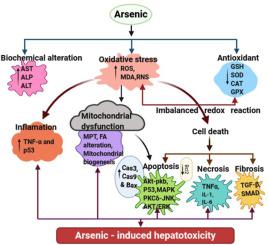Our official English website, www.x-mol.net, welcomes your
feedback! (Note: you will need to create a separate account there.)
An appraisal on molecular and biochemical signalling cascades during arsenic-induced hepatotoxicity
Life Sciences ( IF 5.2 ) Pub Date : 2020-09-17 , DOI: 10.1016/j.lfs.2020.118438 Kaviyarasi Renu 1 , Anusha Saravanan 1 , Anushree Elangovan 1 , Sineka Ramesh 1 , Sivakumar Annamalai 1 , Arunraj Namachivayam 1 , Praveena Abel 1 , Harishkumar Madhyastha 2 , Radha Madhyastha 2 , Masugi Maruyama 2 , Vellingiri Balachandar 3 , Abilash Valsala Gopalakrishnan 1
Life Sciences ( IF 5.2 ) Pub Date : 2020-09-17 , DOI: 10.1016/j.lfs.2020.118438 Kaviyarasi Renu 1 , Anusha Saravanan 1 , Anushree Elangovan 1 , Sineka Ramesh 1 , Sivakumar Annamalai 1 , Arunraj Namachivayam 1 , Praveena Abel 1 , Harishkumar Madhyastha 2 , Radha Madhyastha 2 , Masugi Maruyama 2 , Vellingiri Balachandar 3 , Abilash Valsala Gopalakrishnan 1
Affiliation

|
Arsenic is a ubiquitous metalloid compound commonly found in the environment, and it is usually found in combination with sulphur and metals. Arsenic is considered as a therapeutic as well as poisoning agent since ancient times. It causes toxic effects on different organs, mainly the liver. In this review, we focused on the molecular mechanism of arsenic-induced hepatotoxicity. Here we envisaged the bridge between arsenic and hepatotoxicity with particular focus on the level of hepatic enzymes such as ALT, AST, and ALP. Here, we attempted to elucidate the role of arsenic in redox imbalance on increased oxidative stress (elevated level of ROS, MDA and NO) and decreased antioxidant levels such as reduced GSH, catalase, and SOD. Oxidative stress induces mitochondrial dysfunction via apoptosis (AKT-PKB, MAPK, PI3/AKT, PKCδ-JNK, AKT/ERK, p53 pathways), fibrosis (TGF-β/Smad pathway), and necrosis and inflammation (TNF-α, NF-ĸB, IL-1, and IL-6). Along with that, arsenic activates caspases and Bax, decreases Bcl2 through mitochondrial dysfunction, and induces apoptosis regulatory mechanism. We believe the alteration of all these pathways leads to arsenic-induced hepatotoxicity.
中文翻译:

砷诱导肝毒性过程中分子和生化信号级联的评估
砷是环境中常见的一种普遍存在的准金属化合物,通常与硫和金属结合存在。自古以来,砷就被认为是一种治疗剂和毒剂。它对不同的器官(主要是肝脏)产生毒性作用。在这篇综述中,我们重点关注砷诱导肝毒性的分子机制。在这里,我们设想了砷与肝毒性之间的桥梁,特别关注 ALT、AST 和 ALP 等肝酶的水平。在这里,我们试图阐明砷在氧化还原失衡中的作用,即氧化应激增加(ROS、MDA 和 NO 水平升高)和抗氧化剂水平降低(如 GSH、过氧化氢酶和 SOD 减少)。氧化应激通过细胞凋亡(AKT-PKB、MAPK、PI3/AKT、PKCδ-JNK、AKT/ERK、p53 途径)、纤维化(TGF-β/Smad 途径)以及坏死和炎症(TNF-α、NF)诱导线粒体功能障碍。 -ĸB、IL-1 和 IL-6)。与此同时,砷会激活 caspase 和 Bax,通过线粒体功能障碍降低 Bcl2,并诱导细胞凋亡调节机制。我们相信所有这些途径的改变都会导致砷诱导的肝毒性。
更新日期:2020-09-17
中文翻译:

砷诱导肝毒性过程中分子和生化信号级联的评估
砷是环境中常见的一种普遍存在的准金属化合物,通常与硫和金属结合存在。自古以来,砷就被认为是一种治疗剂和毒剂。它对不同的器官(主要是肝脏)产生毒性作用。在这篇综述中,我们重点关注砷诱导肝毒性的分子机制。在这里,我们设想了砷与肝毒性之间的桥梁,特别关注 ALT、AST 和 ALP 等肝酶的水平。在这里,我们试图阐明砷在氧化还原失衡中的作用,即氧化应激增加(ROS、MDA 和 NO 水平升高)和抗氧化剂水平降低(如 GSH、过氧化氢酶和 SOD 减少)。氧化应激通过细胞凋亡(AKT-PKB、MAPK、PI3/AKT、PKCδ-JNK、AKT/ERK、p53 途径)、纤维化(TGF-β/Smad 途径)以及坏死和炎症(TNF-α、NF)诱导线粒体功能障碍。 -ĸB、IL-1 和 IL-6)。与此同时,砷会激活 caspase 和 Bax,通过线粒体功能障碍降低 Bcl2,并诱导细胞凋亡调节机制。我们相信所有这些途径的改变都会导致砷诱导的肝毒性。











































 京公网安备 11010802027423号
京公网安备 11010802027423号